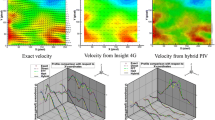Abstract
Most particle-tracking velocimetry (PTV) algorithms are not suitable for calculating the velocity vectors of a fluid flow subjected to strong deformation, because these algorithms deal only with flows due to translation. Accordingly, it is necessary to develop a novel algorithm applicable to flows subjected to strong deformations such as rotation, shear, expansion and compression.
This paper proposes a novel particle tracking algorithm using the velocity gradient tensor (VGT) which can deal with strong deformations and demonstrates that this algorithm is applicable to some basic fluid motions (rigidly rotating flow, Couette flow, and expansion flow). Furthermore, the performance of this algorithm is compared with the binary image cross-correlation method (BICC), the four-consecutive-time-step particle tracking method (4-PTV), and the spring model particle tracking algorithm (SPG) using simulations and experimental data. As a result, it is shown that this novel algorithm is useful and applicable for the highly accurate measurement and analysis of fluid flows subjected to strong deformations.
Similar content being viewed by others
Author information
Authors and Affiliations
Additional information
Received: 9 February 1999/Accepted: 22 November 1999
Rights and permissions
About this article
Cite this article
Ishikawa, M., Murai, Y., Wada, A. et al. A novel algorithm for particle tracking velocimetry using the velocity gradient tensor. Experiments in Fluids 29, 519–531 (2000). https://doi.org/10.1007/s003480000120
Issue Date:
DOI: https://doi.org/10.1007/s003480000120




